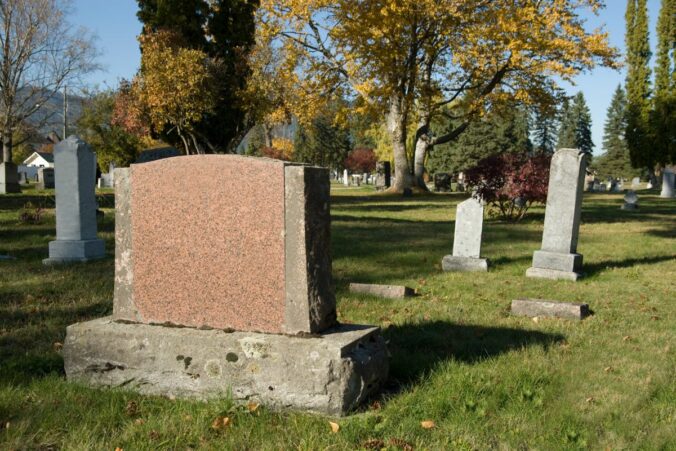Table of Contents
Headstones are an often overlooked but important part of honoring the memory of a loved one. Whether they’re granite or marble, they serve as a permanent reminder of their life and legacy.
It is fascinating to explore the differences between these two materials and learn how they each enhance the beauty and symbolism of headstones.
Headstones are typically constructed from either granite or marble. In general, 95% of headstones in cemeteries today are made from granite while the remaining 5% are usually made from marble due to its higher cost and more delicate nature.
Granite is stronger than marble and can last for centuries with only minimal maintenance required.
Types of Materials Used for Headstones
Headstones are traditionally made from materials that last for a long time and are durable. They must be able to withstand harsh weather conditions as well as the weight of people standing on them or leaning against them.
Common types of headstone materials include granite, marble, sandstone, slate, limestone, quartzite, and other natural stones.
Granite is one of the most popular choices for headstones because it is strong and durable. It can come in many colors including black, grey, pink, and red.
Granite has become very affordable due to modern manufacturing techniques which makes it a popular choice among families looking for an economical solution.
Marble is often used when creating special designs on headstones such as sculptures or engravings. Many cultures use marble to create beautiful monuments that can tell stories about those who have passed away through symbols or carvings found on the stone itself.
Marble also offers a variety of color options depending upon the type selected ranging from white to different shades of reds or blues and greens with subtle veining throughout each slab making it unique in its own way!
Sandstone has been used since ancient times as both a building material and decorative element in cemeteries around the world; however, it may not be suitable for outdoor applications due to its softness compared to some other stone varieties like granite or quartzite.
Using sandstone could cause the headstone to have some erosion over time if exposed frequently enough to rainwater runoff. storms wind etc. The benefit with sandstone though would be if you wanted something more rustic then this might be your best option!
Advantages of Granite Headstones
Granite headstones are becoming increasingly popular due to their durability and classic beauty. They offer a range of advantages over other materials, including:
1. Durability – Granite is highly resistant to weathering and cracking, making it an ideal choice for lasting monuments that will stand the test of time.
2. Versatility – Granite comes in various colors and textures which makes it perfect for creating unique designs or engravings with special meaning.
3. Low Maintenance – The dense surface of granite requires little maintenance, simply wiping down occasionally with soap and water is typically enough to keep them looking great for years!
4. Cost Effective – Although granite may cost more initially than some other materials, its long-lasting quality means you won’t have to replace your headstone as often so overall costs can be kept low in the long term
Disadvantages of Granite Headstones
Granite headstones are a popular choice for many people due to their durable nature, but they come with some drawbacks as well. Here are some of the disadvantages of using granite headstones:
1. Cost – Granite is more expensive than other materials commonly used for headstones such as marble, and it can be difficult to find affordable options in certain areas.
2. Installation – Installing granite requires special tools and techniques that not all stone masons have access to or experience with so it can sometimes take longer to install properly.
3. Maintenance – Granite is prone to staining over time which means it will require regular maintenance if you want your headstone to look its best.
4. Weather Resistance – While granite is highly resistant to weathering, prolonged exposure may still cause discoloration or other damage depending on the climate where the stone is located.
Benefits and Durability of a Marble Gravestone
Marble headstones are a popular choice for many memorials because of their durability, beauty, and range of designs to choose from. Marble is made up of sedimentary rocks composed mainly of calcite which has been metamorphosed.
This process makes it resistant to weathering and acidic environments, making marble ideal for outdoor sculptures or monuments such as a headstone.
Not only can marble withstand the elements, but it also retains its aesthetic qualities over time. Its lustrous surface polishes easily and will remain shiny if given proper care – regular cleaning with a damp cloth should do the trick!
The variety of colors available makes marble an attractive option when compared to other materials such as granite or stone. Additionally, skilled artists can craft intricate patterns in the stone that really stand out in any cemetery setting!
Finally, many people like the fact that marble is timeless and traditional; it’s frequently used to mark gravesites around the world due to its long-lasting nature and stunning look.
Plus, unlike some other materials like wood or plastic which may fade over time due to exposure to rain or sunlight, marble holds up well against those forces – so your loved one’s memory will live on indefinitely through this beautiful material!
Factors that Determine Cost Of Marble or Granite Memorials
The cost of a marble or granite headstone can vary greatly depending on a variety of factors. Here are some of the major considerations when shopping for a headstone:
1. Type/Color of Marble or Granite – The type and color of marble or granite used in a headstone can affect the price significantly, with lighter colors typically being more expensive than darker ones.
2. Size & Shape – Oversized or unusually shaped memorials will likely be more costly due to additional labor involved in their fabrication.
3. Engraving Work – Because engraving is done by hand, it requires skilled craftsmanship and thus costs extra compared to other types of customization such as sandblasting which utilizes machinery rather than manual labor.
4 . Installation Costs – A headstone must also be set properly into the ground at a cemetery; this will usually involve additional fees from qualified professionals who specialize in burial monuments installation services
Cleaning & Maintenance Tips for Marble or Granite Headstone
The most popular materials used for a headstone are marble or granite. Not only do these materials offer a beautiful aesthetic, but they are also incredibly durable and can stand up to harsh weather conditions over time.
When it comes to caring for your loved one’s headstone, there are some simple cleaning and maintenance tips that you should follow in order to ensure its longevity.
First, always use soft cloths when cleaning your headstone so as not to scratch the surface. You can use either warm water with mild soap or even just plain water on a regular basis if dirt has begun to accumulate on the stone surface.
Additionally, never use acidic products such as vinegar or lemon juice as this could cause discoloration of the stone over time due to chemical reactions within the material itself.
In terms of more serious maintenance tasks that require specialized treatments from professionals every few years, sealing is an important step in preserving both marble and granite tombstones from damage caused by weathering agents like UV rays and rainwater absorption.
This will help keep out any moisture that could lead to mold growth and structural problems over time if left untreated.
Finally, polishing is another service that may be necessary for restoring shine back into your loved one’s grave marker after many years of exposure outdoors – though this should generally only be done once every five years at most depending on location and climate conditions where it’s been placed
Conclusion: Which Stone Better?
In conclusion, it is difficult to say definitively which material is better when it comes to a headstone – granite or marble. Each type of stone has its own unique properties that make them attractive for use in a memorial marker.
Granite offers greater strength and durability than marble, making it the preferred choice for outdoor installations in areas with more extreme weather conditions. Marble, however, can provide an elegant and refined look that many people find appealing due to its smooth texture and varied color options.
Ultimately, the decision of which material best suits your needs should be based on personal preference as both has advantages and disadvantages depending on their intended application.



Leave a Reply